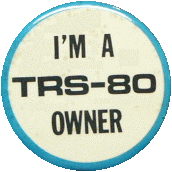 Daves Old Computers - TRS-80 (Z80 based)
Daves Old Computers - TRS-80 (Z80 based) Daves Old Computers - TRS-80 (Z80 based)
Daves Old Computers - TRS-80 (Z80 based)The TRS (Tandy Radio Shack) line of computers includes many models based on the Z80 processor. The first TRS machines could only run ROM BASIC, then disk drives were added, and TRS-DOS was created.
Although these Z80 based machines are what are commonly referred to as "TRS-80", several other distinct computer architectures were also marketed under this name, including: TRS-80 Color Computer, TRS-80 Model 100/102/200 and the TRS-80 Pocket Computer.
Click any photo to view a large high-resolution image.
 This is the original TRS-80 - first released in 1977, this machine consists
of a main unit incorporating the keyboard, CPU,
memory and supporting devices, and an monitor which
was a rebadged RCA TV from which the tuner had been removed.
This is the original TRS-80 - first released in 1977, this machine consists
of a main unit incorporating the keyboard, CPU,
memory and supporting devices, and an monitor which
was a rebadged RCA TV from which the tuner had been removed.
Program storage was originally by cassette tape, however a separate expansion unit was later produced which supported more RAM, and the connection of floppy disk drives. A fully configured TRS-80 was quite a maze of wires and boxes.
Views: main-unit bottom, monitor back, users manual.
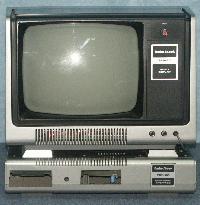 This is the Model I expansion unit. It sits under the monitor and provides
the Model 1 with more memory, floppy diskette capability as well as additional
peripheral interfaces.
This is the Model I expansion unit. It sits under the monitor and provides
the Model 1 with more memory, floppy diskette capability as well as additional
peripheral interfaces.
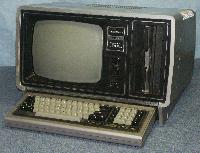 The TRS-80 Model II is a complete departure from the original TRS-80 design.
It includes an integrated monitor, and an 8" diskette drive. Unlike other
TRS-80 models, this machines does NOT have BASIC in ROM. It was designed as
a business machine (with a price to match), and loaded all of its system
software from disk. Internally, this system
is bus oriented, with cards for the CPU, Memory and disk controller. It
is also expandable, and options such as a 68000 CPU card were available.
The TRS-80 Model II is a complete departure from the original TRS-80 design.
It includes an integrated monitor, and an 8" diskette drive. Unlike other
TRS-80 models, this machines does NOT have BASIC in ROM. It was designed as
a business machine (with a price to match), and loaded all of its system
software from disk. Internally, this system
is bus oriented, with cards for the CPU, Memory and disk controller. It
is also expandable, and options such as a 68000 CPU card were available.
Unlike other "All in one" TRS-80 Models, the back
of the Model II contains all of the I/O connectors.
One Model-II donated by Willem Boon.
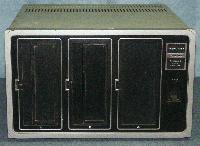 If the whopping 500k of disk storage offered by the Model II's internal
single-sided 8" diskette drive was not enough, you could add this external
drive expansion unit with up to three more drives.
If the whopping 500k of disk storage offered by the Model II's internal
single-sided 8" diskette drive was not enough, you could add this external
drive expansion unit with up to three more drives.
Like the Model II, this unit is larger than it appears in these photos... Remember that these are full sized 8" diskette drives!
Here is a view from the back.
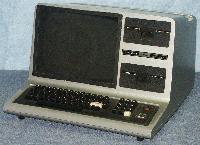 The TRS-80 Model III is pretty much the original TRS-80 design, repackaged
into a single unit which incorporates the keyboard, monitor, CPU & expansion
devices as well as two diskette drives.
The TRS-80 Model III is pretty much the original TRS-80 design, repackaged
into a single unit which incorporates the keyboard, monitor, CPU & expansion
devices as well as two diskette drives.
The back of the Model III is quite plain. All switches, controls and I/O connections except for cassette are located on the bottom of the machine.
Here is a look inside, and a closeup of the system board.
 TRS-80 Model III documentation.
TRS-80 Model III documentation.
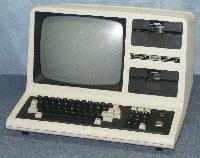 The TRS-80 Model 4 looks like the Model III, however it has major
improvements which make it much more powerful. The most important of these
is the ability to MAP out the ROMs and run with 64k RAM. This allows the
computer to run CP/M - the industry standard operationg system at the time.
It also allowes up to 128k RAM and has several other enhancements.
The white case was a departure of previous "grey" TRS-80 models.
The TRS-80 Model 4 looks like the Model III, however it has major
improvements which make it much more powerful. The most important of these
is the ability to MAP out the ROMs and run with 64k RAM. This allows the
computer to run CP/M - the industry standard operationg system at the time.
It also allowes up to 128k RAM and has several other enhancements.
The white case was a departure of previous "grey" TRS-80 models.
The back of the Model 4 is quite plain. All switches, controls and I/O connections except for cassette are located on the bottom of the machine.
Donated by Jim Fare.
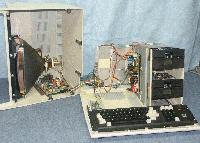 Inside the TRS-80 Model 4. Note that the monitor is attached to the
cover, not the main computer frame. Also note that there is only one
power supply (The Model III has two power supplies).
Inside the TRS-80 Model 4. Note that the monitor is attached to the
cover, not the main computer frame. Also note that there is only one
power supply (The Model III has two power supplies).
The main logic board is located vertically at the rear of the machine. There are two more boards located between it and the panel that you can see behind the diskette drives - these are the diskette controller, and the serial I/O interface board.
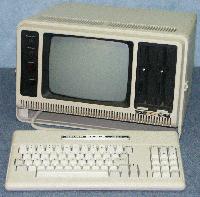 This is a TRS-80 Model 4P - the only "portable" Z-80 based TRS-80 ever
made. The 4P is essentially a Model 4 in a portable case, although it
does omit the Model III BASIC mode ROMS (which can be loaded from disk).
This is a TRS-80 Model 4P - the only "portable" Z-80 based TRS-80 ever
made. The 4P is essentially a Model 4 in a portable case, although it
does omit the Model III BASIC mode ROMS (which can be loaded from disk).
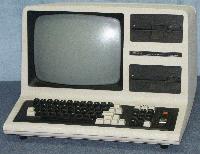 The Tandy Model 4D is the last and most powerful TRS-80 made. It is similar
to the standard Model 4, except that it has double-sided disk drives, and
an improved gate-array mainboard. Note that it now bears the TANDY name instead
of TRS-80.
The Tandy Model 4D is the last and most powerful TRS-80 made. It is similar
to the standard Model 4, except that it has double-sided disk drives, and
an improved gate-array mainboard. Note that it now bears the TANDY name instead
of TRS-80.
One small but handy improvement is that the serial port has been redirected to be accessable from the back of the machine.
I have been unable to determine exactly when the TRS-80 line was discontinued, however this machine does appear in the 1987 Tandy Computer Catalog.
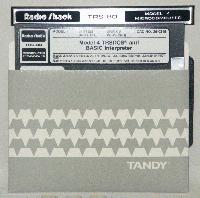 Here is an original TRSDOS boot disk for the TRS-80 Model 4.
Here is an original TRSDOS boot disk for the TRS-80 Model 4.
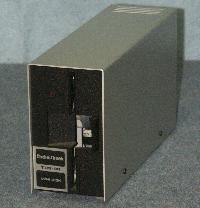 To use a diskette drive on the Model-I, or to add an extra disk to the
Model III or 4, you needed one (or two) of these TRS-80 "MiniDisk" drives.
To use a diskette drive on the Model-I, or to add an extra disk to the
Model III or 4, you needed one (or two) of these TRS-80 "MiniDisk" drives.
The Model-I also requires a "expansion" box which contains the diskette controller.
Here is a view of the back.
1984 catalog accessory page.
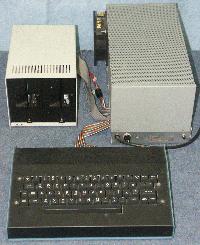 The most unique TRS-80s I've ever seen - click the photo on the left to visit
my page on two homebuilt TRS-80s on S-100 cards!
The most unique TRS-80s I've ever seen - click the photo on the left to visit
my page on two homebuilt TRS-80s on S-100 cards!
These things really run, and perform exactly like factory TRS-80s!